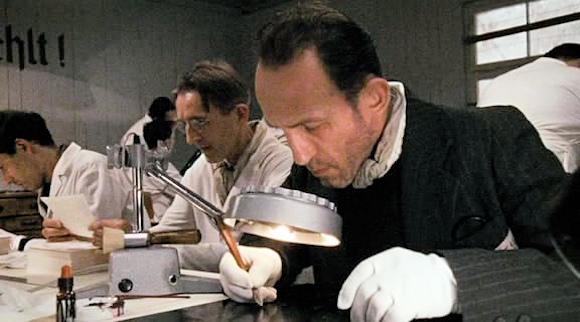Operation "Bernhard" was the name of a secret German plan, developed to undermine the British economy through the massive introduction of fake banknotes from 5, 10, 20 and 50 pounds. In 1936 begins the story of a Jewish falsifier, Salomon Sorowitsch, arrested by the Nazis and then in the concentration camp of Sachsenhausen, in a special shack totally isolated from the others, in which a staff of prisoners, skilled typographers, is hired to falsify foreign currency and bonds, in order to inflate and destroy the British and US economy, in exchange for a considerable reduction in deprivation suffered in the other camps.
In the Sachsenhausen camp, the 18 and 19 barracks remained constantly closed. Their roofs were covered with barbed wire, a layer of lime had been passed over the windows. Some specially selected SSs slept with the deported 150 who worked there. Every now and then trucks came up to the threshold of the barracks and took away mysterious crates, defended by powerful armed escorts. Getting in touch with the men of "Kommando T" meant condemning themselves to immediate execution. The 6 Section of the RSHA had created a clandestine branch in Sachsenhausen of the Bank of England where it printed fake currency. The deportees of the 18 and 19 barracks, were very talented engravers and designers, framed by real speciaists in the printing of banknotes and securities. The SS Sturmbannfuhrer Berhard Kruger (1904-1989), Head of Unit VI F 4a of the Ministry of Security of the Reich, was responsible for this operation. This department was responsible, among other things, for passports and falsifications of documents.

German chemists discovered that the paper used by the Bank of England was made from the ramia, a fibrous plant cultivated in India. After some experimentation the results were astonishing, the sterling manufactured by the Germans, delivered to neutral banks and then to British banks were declared authentic. The tickets had been pierced with pins, equipped with numbers that were perfectly studied and had undergone an artificial aging that gave them a worn look. From then on the 18 and 19 shacks worked at full speed, producing 5, 10, 20 and 50 pounds. The card for the counterfeiting of money originated first in the Spechthausen paper factory in the province of Brandenburg and subsequently the paper production was transferred to the Hahnemuhle paper mill in Relliehausen. The paper mill produced around 1,5 millions of sheets for pound notes. Production peaked in the summer of 1943 with about 650.000 banknotes a month.
In order to circulate them abroad, the RSHA 6 Section Walter Shellenberg and Ernst Kaltenbrunner were entrusted with the large distributors and main users of the famous coin produced by the "Bernhard" operation. An organization based on collaborators of aristocratic family worked in Spain starting from 1941, allowing to sell large quantities of false pounds. The neutrality of Spain made it possible to change the fake currency with strategic raw materials essential to the German war industry. Then the RSHA services extended their business operations and dedicated themselves to increasingly important trades. Sachsenhausen's Kommando T was a real gold mine, on the stock exchanges of Switzerland, Portugal, Spain and Turkey the bank of Sachsenhausen made the secret services of the Nazi party more than 150 millions of Reichsmarks and more than 50 million francs. The Bank of England recognized in the 2003 that the counterfeiting operation had seriously threatened the stability of the pound during the war. Much of the counterfeit money, enclosed in metal boxes, in the last days of war, was thrown by the Nazis in Lake Topliz in Austria.
The allied experts later evaluated the production of counterfeit money at about 120 million pounds. Lawrence Malkin published in the 2006 "Krueger's Men" in which he analyzed the Operation Bernhard, considered to be the largest counterfeiting operation in the history of pounds sterling, of all history. Thanks above all to the typographer Adolf Burger, born in a Slovak village, as a boy working as a typographer he became so skilled that, in a militant movement, he made false documents to help the Jews expatriate. The 5 May 1945 Ebensee Sonderkommando was delivered to the Red Cross. Almost all the 142 concentration camp prisoners had survived and were released. The story of the "Bernhard" operation was made known to the general public with the film "The Counterfeit Operation Bernhard" by 2007 directed by Stefan Ruzowitzky, winner of the Oscar 2008 as best foreign film. The plot of which is based on the Bernhard Operation; Austrian actor Karl Markovics plays Salomon Sorowitsch, a character referring to the Russian counterfeiter Salomon Smolianoff. The film ends in the casino of Monte Carlo where Sorowitsch, now safe but with a perpetually marked face, dilapidated the game all the dollar currency printed for the torturers.












